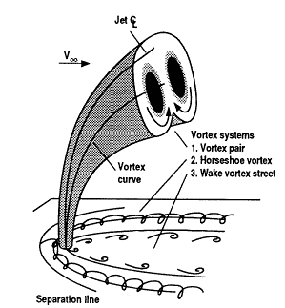Abstr:Jet in a Cross Flow
Free Flows
Underlying Flow Regime 1-05
Abstract
Understanding the underlying flow regime of a jet in cross flow documented here is basic to solving several problems of considerable practical importance in aeronautics, civil engineering, environmental engineering and turbomachinery. This flow regime has been systematically studied since the first half of the twentieth century. In 1993 the Advisory Group for Aerospace Research and Development (AGARD) organized a conference with the title ‘Computational and Experimental Assessment of Jets in Cross Flow’. Thirty seven papers were presented, showing the vigour of this subject as a field of research. Margason (1993) gives a list of the main applications of knowledge about jets in cross flow:
Plume dispersion from smoke stacks and volcanos: This is a pollution problem where smoke concentration is of interest. The smoke leaves either the stack or the volcano with an upward momentum due to buoyancy into a stagnation air mass or into a cross wind. So it is usual to make the analysis of the motion caused by buyancy until it becomes negligible and then to consider a diffusion formulation.
Effluent dispersal into streams: This is also a pollution problem where the focus of research is diffusion of the jet into a lake or a river. The goal is the identification of the polluted region and the estimation of the concentration of pollutant. This analysis often happens in the design of sewage treatment and disposal systems.
Turbomachinery cooling and fuel injection: In cooling, the problem is to protect the components of the combustor or the turbine against very high temperatures, adopted for purposes of efficiency. The optimum design of a cooling system will protect the components using as little cooling medium as possible and affecting the efficiency of the component as little as possible. In fuel injection, the designer wishes to achieve the best possible quality of mix of fuel and air.
Control jets: On underwater vehicles and on aircraft, control jets are used to produce control moments. Interest here is on the interaction between different flows and their effect on the control moment.
Vertical and/or Short Take Off and Landing aircraft (V/STOL): This has probably been the most important application of the study of jets in cross flow. The problem is to minimise the loss in lifting force and the nose-up pitching moment caused by the jet. Objectives also include the minimisation of ground damage, of modification of aerodynamic forces and moments and of ingestion of hot, exhausted gases in engine inlets.
The Physics of a Jet in Cross Flow: The physical phenomenon is described by several authors. However, some differences of interest imply different descriptions of the fundamental aspects of the flow regime. So, those who are interested in V/STOL, describe a system where we have a jet, a cross flow and a wall, normal to the jet exit. We will concentrate our attention on a flow system that is of interest to turbomachinery and environmental engineers.
A jet exhausting into a cross flow follows a curved path downstream while its cross section changes (see Fig. 1.1). For the case of a circular jet (Margason (1993)), the pressure distribution due to potential flow around a rigid circular cylinder can be considered. The pressure coefficient is given by . At and there are stagnation points and Cp=1. At the lateral edges, whereand , the pressures reach a minimum and Cp=-3. The flow then spreads laterally into an oval shape. At the same time the cross flow shears the jet fluid along the lateral edges downstream to form a kidney-shaped cross section. At increasing distances from the jet exit, the shearing folds the downstream face over itself to form a vortex pair. Fig. 1.1 also shows the secondary vortices: the horseshoe vortex and the wake vortex street.
The ratio R = (jet velocity / cross flow velocity) is of particular importance. When R is high (6, 8, 10 or more - see for example Keffer and Baines 1962), the jet penetrates far across the main flow. If R is low, the jet tends to bow at a short distance from the orifice. Fig. 1.2 (a), from Andreopoulos and Rodi (1984) shows the case of R=0.5. The jet bends immediately after leaving the orifice. The main flow is slightly distorted by the jet and, downstream the orifice, it looks like a ‘cover’, under which the fluid of the jet flows. Fig. 1.2 (b) (same authors) shows the case of R=2. With a higher velocity, the jet penetrates into the cross stream before being bent over. The jet is weakly affected near the exit. In both cases, wakes with complex flow patterns are formed downstream the jet. Close to the wall, a region of reverse flow forms. Cross stream fluid that enters this region moves upstream, is lifted by the jet and then moves downstream with the fluid of the jet. As the jet is bent, its cross section is distorted by two counter rotating vortices, taking the shape of a kidney, as mentioned above. This secondary motion decays in the downstream direction under the action of turbulent stresses. The approaching boundary layer has negative vorticity, which is increased as the jet is bent. In the pipe, near the exit, the counter-rotating vorticity is formed by the coss stream moving around the jet.
The basic feature of Jet in Cross Flow is the mutual deflection of jet and cross flow. The jet is bent over by the cross stream, near the wall if R is low and far from the wall if R is high. The cross stream is deflected as if it had hit a rigid obstacle. The vortices form when the wall boundary layer encounters an adverse pressure gradient at the front of the jet and separates.
Contributors: Flavio Franco - ABB ALSTOM Power UK Ltd
{{#set:hasContributorOrg=ABB ALSTOM Power UK}} {{#set:hasContributorPerson=Flavio Franco}} {{#set:hasQualityAccessLevel=Silver}}


